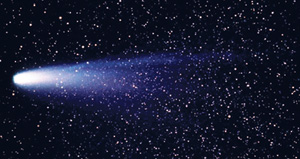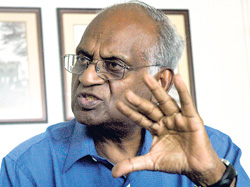There’s a fascinating story behind how Devamitta Asoka Mendis, Professor Emeritus, spent the entirety of 1986 as an honorary Hungarian. It began as Halley’s Comet sped toward the sun. In a truly historic moment, five spacecraft were to meet it. For Prof. Mendis, the comet was no harbinger of doom, but what the spacecraft discovered could confirm or debunk years of study and research.
The astronomer felt his nerves leap in anticipation as he gazed at a screen in IKI’s Moscow headquarters. IKI -- the Space Research Institute of the Russian Academy of Sciences -- was the Soviet equivalent of the American NASA. With the United States and the Soviet Union still in the grip of the Cold War, there wasn’t room for another American scientist on the team – but there was a slot for a Hungarian. The Soviets, desperate to have Prof. Mendis – one of the few theoreticians capable of analysing Vega’s payload – decided to offer him a temporary change in nationality.
 |
| Halley’s Comet |
Sharing the viewing room with him was the American astronomer Fred Whipple. Credited with the “dirty snowball” theory of comets, Whipple was the man who postulated the existence of a cometary nucleus. The theory was hotly contested. But as the first of more than 1,500 photographs streamed into the room, both men had the satisfaction of knowing they guessed right. “That was a time when the centre of all activity was supposed to be in the nucleus of a comet – but we had never seen the nucleus of a comet...until then,” says Prof. Mendis.
Born in Sri Lanka, he moved to America in 1969 – two weeks before they put Neil Armstrong and Buzz Aldrin on the moon. Despite having graduated from the University of Colombo with a degree in Mathematics, and having subsequently taught at the university, his interest turned to astrophysics as he completed both his D.Sc and PhD on the subject at the University of Manchester. When he moved to the United States to work on the University of Californias San Diego campus, he found a country in the grip of space fever, one well able to support his research into the solar system’s oldest nomads – comets.
Growing up in Sri Lanka, Prof. Mendis, son of a surveyor, travelled the island. His father allowed him to use his telescope, and helped him find the planets as they scoured the night sky together.
Today, at 74 going on 75, Prof. Mendis still possesses that same sense of wonder and intense curiosity about the universe. Comets in particular fascinate him. In a solar system born of the gradual agglomeration of dust and debris in the sway of gravity, comets “are a sort of intermediate stage between these small dust grains and the planets,” he says.
“As planets formed, the comets themselves would have agglomerated into planets, but some of them just got kicked out,” he explains, pointing to the Oort Cloud and distant Kuiper Belt which may harbour over a trillion comets. “They are really in a sense, very primitive bodies and if you want to study the chemical composition of the physical environment of the solar system while it was in the process of formation, comets are the place to go.”
His work on Halley’s Comet remains one of the highlights of a career that spans over four decades, but it is his Gravito-Electrodynamic Theory (G.E.D) that engrosses him now. Its multidisciplinary applications have him exploring a cure for anthrax and the creation of a commercially viable way to harness fusion energy. He traces the roots of the theory to a 1974 paper, penned with his colleague Ian Axford, on one of Saturn’s moons – Iapetus.
When Giovanni Cassini discovered the moon in 1671, he was puzzled by how one hemisphere gleamed white, while the other remained mysteriously dark. Prof. Mendis speculated that the dramatic difference between the two hemispheres was due to differential accumulation of dust particles on either side – a hypothesis that was confirmed by data gathered by the Cassini spacecraft in recent years. The theory would come to its full fruition when he was given a chance to study the rings of Saturn.
Mysterious “radial spokes” that seemed to rotate around the ring plane, led one baffled physicist to declare that they could not be understood according to the laws of physics. Unfortunately, he made his statement in the hearing of the Nobel Prizewinning Swedish physicist Hannes Alfvén – Prof. Mendis’ colleague.
Prof. Alfvén’s acerbic response – “there is a difference between the known laws of physics and the laws known to you,” would be proved true when Prof. Mendis published a paper ‘Gravito-electrodynamics and the structure of planetary ring systems’ in the early eighties. Having studied the behaviour of micron and sub-micron sized dust particles in the Saturnian and Jovian ring systems, Prof. Mendis advocated a radical explanation for the strange phenomena they were witnessing.
“After calculating the electrical charge on these grains, I realised that there were electrical forces, besides gravitational forces, operating on these particles. Then I realised the two forces were comparable – the so called electrodynamic forces created by the rotation of the magnetosphere over the planet – and the gravitational forces. I combined the two – calling it gravito-electrodynamic theory”.
Prof. Mendis explains all this with barely a pause between his words. His quick speech, marked by a rolling ‘r’ is suffused with enthusiasm. The theory has extended into his research on dusty plasmas – what he likes to call “a new interdisciplinary frontier”.
“It’s now gone from explaining things in space to applications down here, for instance in chip manufacture and fusion research.” Nuclear fusion, unlike nuclear fission, promises a clean and abundant source of energy. “We’ve been trying to replicate what happens in the sun for nearly fifty years now...sometimes I think we’re tantalisingly close to a solution, but we’re not quite there and I can’t predict when it will happen,” he says.
Currently he is occupied with the way particles behave in a tokamak – a magnetic “bottle” that is one of the few structures capable of containing the superheated plasma essential to the fusion process. A Russian scientist who heard him discussing G.E.D’s appearance in Saturn’s rings recruited him to help solve the unexpected appearance of radioactive dust particles in tokamaks. “The situation is almost the same as in Saturn, but the geometry is different,” says Prof. Mendis, adding with evident satisfaction, “The basic laws of physics don’t change with scale.” He’s also come a full circle – in his determination to understand the workings of dusty plasmas, he’s rediscovering comets.
“The tail of a comet is a good cosmic laboratory in which to study dusty plasma,” he says.
He tells me that on the surfaces of the tiny dust grains in a comet’s tail, a war is being fought. Two forces tug against each other -- electrostatic tension on the surface of the grains attempts to rip the grain apart, while the grain’s inherent tensile strength struggles to keep it together. This finding had unexpected applications. “Like dust, bacteria are also micron sized particles,” he says, “if you could charge them electrically you might be able to disrupt them.
” It was a profound insight in terms of bio-technology – “we’ve found a new way of killing bacteria that is not electro-chemical, its electro-physical.” The same disruptive forces could even be applied to the thin protein membranes of the hibernating anthrax spores, so that they simply burst open, rendering them harmless. Such finds have sparked a tsunami of interest. “Ten years ago, dusty plasmas were the fastest growing sub-disciplines of physics, but now it’s simply one of the fastest growing disciplines altogether.”
Though he continues to pursue his research and is a valued consultant, Prof. Mendis is now retired from active teaching. He maintains his ties with Sri Lanka in the form of his work with the Foundation of Goodness, an organisation devoted to helping communities recover post tsunami. He and Janine, his wife of 35 years, are based in San Diego, where he says he spends much of his time reading and exploring other disciplines. He expects dusty plasmas to surprise him for years to come.
In the spectacular photographs taken by the Hubble Space Telescope, he sees it surging through the ‘cosmic nurseries’ of galaxies – the places where stars die and are reborn – and in medical laboratories, industrial factories, and fusion labs, new discoveries are made every day. In this pursuit of knowledge he finds his life’s purpose and man’s great motivation – “I really think this is why we’re here,” he says simply. |



